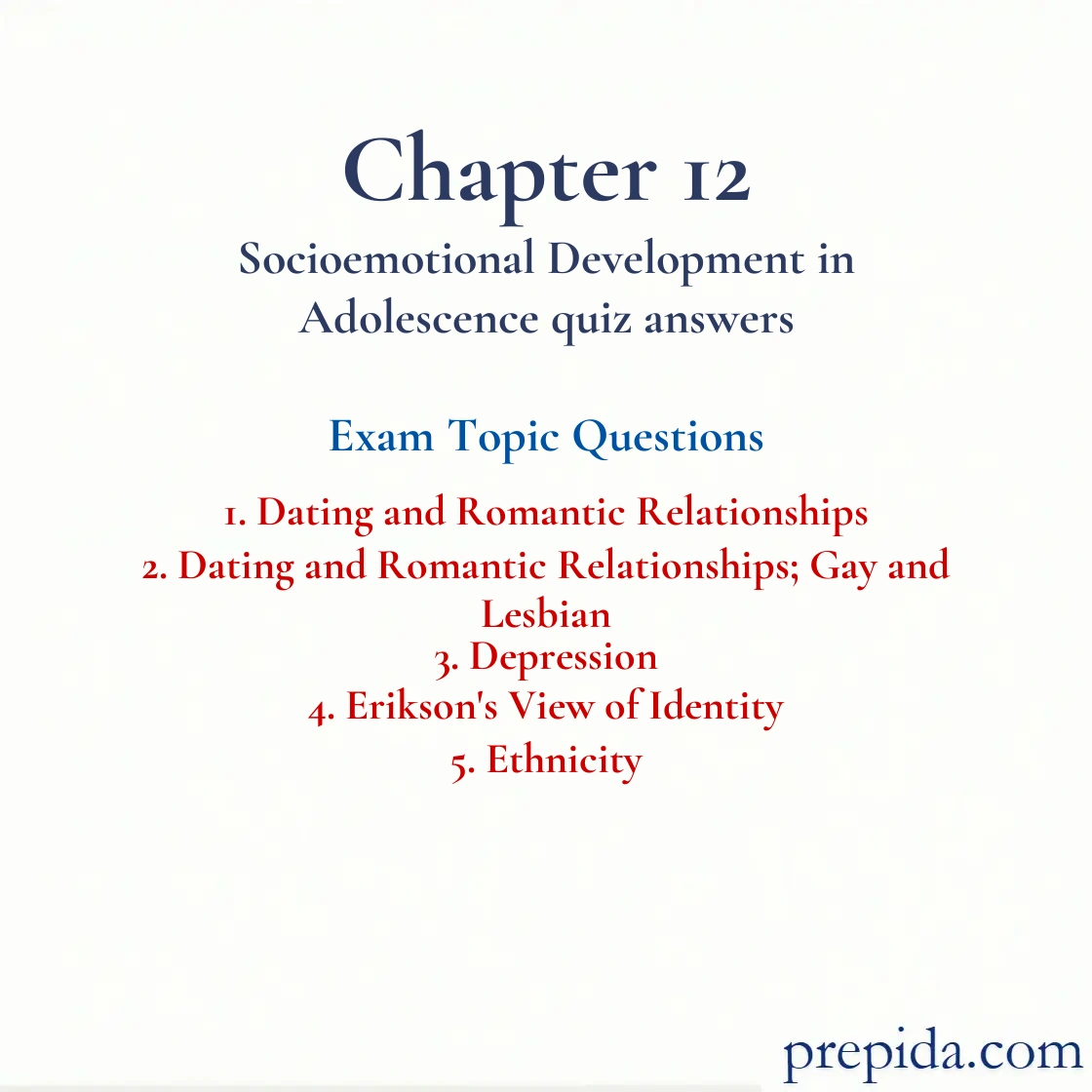
Which of the following is the last stage of the development of romantic relationships in adolescence?
- consolidating dyadic romantic bonds
- entry into romantic attractions and affiliations
- dating in groups, reflecting embeddedness in the peer context
- exploring romantic relationships
Bonding: The formation of a close connection, especially a physical bond, between parents and their newborn in the period shortly after birth.
Late bloomers comprise approximately 10 percent of ________ who say that they have had no experience with romantic relationships.
- 14- to 16-year-olds
- 17- to 19-year-olds
- 12- to 13-year-olds
- 15- to 16-year-olds
Adolescent Egocentrism: The heightened self-consciousness of adolescents.
Which of the following statements about dating in gay and lesbian youth is true?
- Sexual minority youth seldom date other-sex peers to disguise their sexual orientation from others.
- Most gay and lesbian youth seldom have same-sex sexual experience.
- Gay and lesbian youth do not get emotionally affected by the breakup of a same-sex relationship they were involved in.
- Some gay and lesbian youth continue to have a same-sex orientation while others have a primarily heterosexual orientation.
The most effective way to treat adolescent depression is
- through antidepressant medication such as Prozac.
- not with medication but through cognitive behavior therapy.
- a combination of psychoanalysis and family treatment.
- a combination of drug therapy and cognitive behavior therapy.
Behavior Genetics: The field that seeks to discover the influence of heredity and environment on individual differences in human traits and development.
Which of the following statements is true about depression in adolescents?
- Females tend to ruminate in their depressed mood and amplify it; hence, they are more likely to develop depression than are males.
- Puberty occurs earlier for males than for females; hence, males are more likely to develop depression than are females.
- Males face more discrimination than females do; hence, males are more likely to develop depression than are females.
- Females' self-images, especially their body images, are more positive than males'; hence, females are less likely to develop depression than males.
Gender: The characteristics of people as males or females.
Adolescents who do not successfully resolve their identity crisis suffer from what Erikson calls ________.
- identity diffusion
- unresolved identity
- identity confusion
- identity moratorium
Identity Diffusion: Marcia’s term for the status of individuals who have not yet experienced a crisis (explored meaningful alternatives) or made any commitments.
Mike is 14 years old. When asked what he wants to be when he grows up, he promptly replies that he wants to be a lawyer and begins to speak about a recent case and how well the lawyers handled the case. However, his mother casually mentions that Mike's interests change almost every few weeks and that she feels that Mike should attend some career guidance sessions to decide what he wants to become. In the context of Erik Erikson's fifth developmental stage, this period of Mike's life is referred to as a ________.
- sociological amnesty
- societal moratorium
- psychosocial moratorium
- behavioral reprieve
Identity Moratorium: Marcia’s term for the status of individuals who are in the midst of a crisis, but their commitments are either absent or vaguely defined.
Which of the following is Erikson's fifth developmental stage?
- identity versus identity confusion
- autonomy versus shame and doubt
- initiative versus guilt
- intimacy versus isolation
Identity Diffusion: Marcia’s term for the status of individuals who have not yet experienced a crisis (explored meaningful alternatives) or made any commitments.
According to Erik Erikson, which of the following developmental stages is experienced by an individual during adolescence?
- autonomy versus shame and doubt
- intimacy versus isolation
- initiative versus guilt
- identity versus identity confusion
Identity Diffusion: Marcia’s term for the status of individuals who have not yet experienced a crisis (explored meaningful alternatives) or made any commitments.
According to Erik Erikson, during the ________ stage, adolescents are faced with deciding who they are, what they are all about, and where they are going in life.
- autonomy versus shame and doubt
- identity versus identity confusion
- initiative versus guilt
- intimacy versus isolation
Which of the following terms did Erik Erikson use to describe the gap between childhood security and adult autonomy?
- psychosocial moratorium
- sociological amnesty
- societal moratorium
- behavioral reprieve
Identity Moratorium: Marcia’s term for the status of individuals who are in the midst of a crisis, but their commitments are either absent or vaguely defined.
Which of the following terms did Erikson use to describe a period in which society leaves adolescents relatively free of responsibilities and free to try out different identities?
- sociological amnesty
- societal moratorium
- psychosocial moratorium
- behavioral reprieve
Identity Moratorium: Marcia’s term for the status of individuals who are in the midst of a crisis, but their commitments are either absent or vaguely defined.
The double disadvantage suffered by ethnic minority adolescents includes
- the lack of clear rites of passage.
- diversity and difference.
- prejudice and poverty.
- hostility and assimilation.
Identify the dual struggle often faced by immigrants to the United States.
- to acculturate and take on a new identity
- to work and take care of their children
- to preserve their culture and resist change
- to preserve identity and to acculturate
Assimilation: Piagetian concept of using existing schemes to deal with new information or experiences.